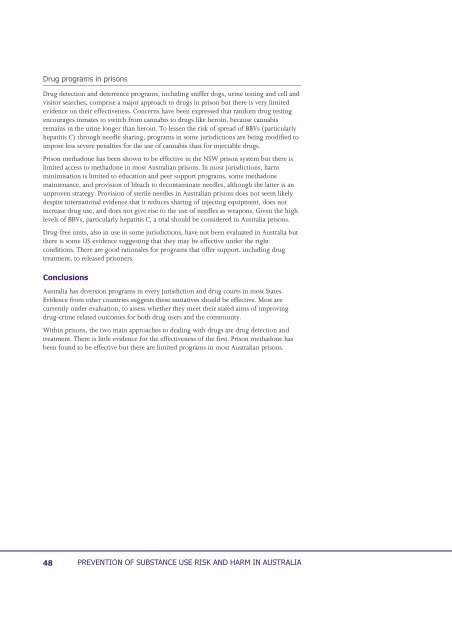Summary - Department of Health and Ageing
Summary - Department of Health and Ageing
Summary - Department of Health and Ageing
You also want an ePaper? Increase the reach of your titles
YUMPU automatically turns print PDFs into web optimized ePapers that Google loves.
Drug detection <strong>and</strong> deterrence programs, including sniffer dogs, urine testing <strong>and</strong> cell <strong>and</strong><br />
visitor searches, comprise a major approach to drugs in prison but there is very limited<br />
evidence on their effectiveness. Concerns have been expressed that r<strong>and</strong>om drug testing<br />
encourages inmates to switch from cannabis to drugs like heroin, because cannabis<br />
remains in the urine longer than heroin. To lessen the risk <strong>of</strong> spread <strong>of</strong> BBVs (particularly<br />
hepatitis C) through needle sharing, programs in some jurisdictions are being modified to<br />
impose less severe penalties for the use <strong>of</strong> cannabis than for injectable drugs.<br />
Prison methadone has been shown to be effective in the NSW prison system but there is<br />
limited access to methadone in most Australian prisons. In most jurisdictions, harm<br />
minimisation is limited to education <strong>and</strong> peer support programs, some methadone<br />
maintenance, <strong>and</strong> provision <strong>of</strong> bleach to decontaminate needles, although the latter is an<br />
unproven strategy. Provision <strong>of</strong> sterile needles in Australian prisons does not seem likely<br />
despite international evidence that it reduces sharing <strong>of</strong> injecting equipment, does not<br />
increase drug use, <strong>and</strong> does not give rise to the use <strong>of</strong> needles as weapons. Given the high<br />
levels <strong>of</strong> BBVs, particularly hepatitis C, a trial should be considered in Australia prisons.<br />
Drug-free units, also in use in some jurisdictions, have not been evaluated in Australia but<br />
there is some US evidence suggesting that they may be effective under the right<br />
conditions. There are good rationales for programs that <strong>of</strong>fer support, including drug<br />
treatment, to released prisoners.<br />
<br />
Australia has diversion programs in every jurisdiction <strong>and</strong> drug courts in most States.<br />
Evidence from other countries suggests these initiatives should be effective. Most are<br />
currently under evaluation, to assess whether they meet their stated aims <strong>of</strong> improving<br />
drug-crime related outcomes for both drug users <strong>and</strong> the community.<br />
Within prisons, the two main approaches to dealing with drugs are drug detection <strong>and</strong><br />
treatment. There is little evidence for the effectiveness <strong>of</strong> the first. Prison methadone has<br />
been found to be effective but there are limited programs in most Australian prisons.

















